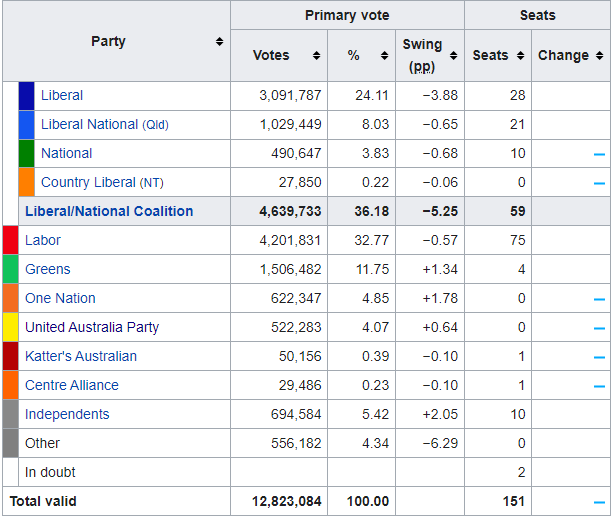
The Australian Federal Election earlier this month saw incumbent Prime Minister Scott Morrison thrown out for Labour Leader Anthony Albanese. Although this was predicted by many, few predicted how little support the two major Establishment parties would get. Even fewer predicted such a strong nationalist vote.
Australian dissatisfaction with the ruling class has not been this high ever. In 1910, Labor and the Coalition combined won 95.1% of the vote. In 1949 they won 96.3%. As recently as 1993 it was 89.2%. But after the advent of neoliberalism, support for Establishment parties has collapsed.
By 2010 the combined vote for the Establishment Left and the Establishment Right had fallen to 81.3%. By 2013 it was 79%, by 2016 it was 76.7%, by 2019 it was 74.7% and by 2022 it was 68.9%. The pattern is stark and unidirectional. Support for the Establishment in general is falling fast in Australia, as it is in most other Western countries.
This falling support for the Australian Establishment reflects the falling standard of living across the Western World. People are less satisfied than ever about the way their countries are being run. Housing is rapidly becoming unaffordable even in countries as wealthy as Australia – the average house price in Sydney is now AUD1,600,000, which is an enormous amount of money even with Aussie wages.
Like most Westerners, Australians feel like they’re getting poorer, and have done for a while. Not only is the increasing cost of living making it hard for Australian families, but there is no sign on the horizon of things getting any better. Elections are often won or lost on economic perceptions. As such, it’s not surprising to have seen a swing against the incumbent powers this year.
A more surprising feature of the 2022 Australian election was the resurgence of nationalist movements.
Pauline Hanson’s One Nation Party was the 4th biggest party, with 628,254 votes, and Clive Palmer’s United Australia Party was 5th with 522,283. Adding Bob Katter’s Australian Party takes the nationalist vote to over 9%. Considering the nationalist sentiments of some of the independents it is fair to suggest that the full nationalist vote was around 10%.
This nationalist vote is the result of increasing awareness of the failures of globalism. Australians, like most Westerners, have now figured out that globalism just means lower wages, higher rents, and more crime. All the benefits that we were promised accrued to those who already had wealth. The rest of us just lost out.
The globalist Establishment doesn’t care about the electorate swinging back and forth on the left-right spectrum. They control both the left and the right anyway. What they’re really worried about is a resurgence of nationalism. This creates the possibility of putting someone in power who the Establishment doesn’t already control.
The two major nationalist movements in Australia together won about 10% of the total vote, which raises the question: could a similar nationalist movement win 10% of the vote in New Zealand?
The collapse of the New Zealand First Party (polling at a mere 1% according to latest numbers) means that nationalist narratives have fallen out of the popular consciousness in New Zealand. The mainstream media, on behalf of its globalist owners, presents us with a choice between the globalist left and the globalist right. Nationalist ideas are unthinkable.
But if nationalist movements can get 10% of the vote in Australia, there’s every reason to think they could do similarly well in New Zealand. Kiwis have also been poorly served by globalism, which has also sent our productive capacity overseas while flooding our neighbourhoods with cheap labour. We have very similar attitudes to Australians when it comes to such things.
It would certainly be an uphill struggle.
Because nationalism is equated so closely to Nazism in the propaganda and brainwashing machine that is the mainstream media, any new nationalist movement in New Zealand could expect to get smeared as white supremacists immediately, and compared to Brenton Tarrant.
But nationalist movements have done well in New Zealand before. New Zealand First won 10% of the vote as recently as 2002, as voters realised that Helen Clark was happy to destroy the New Zealand working class through the mass importation of cheap Third World labour, and sought an alternative.
The Establishment has worked hard to smear New Zealand First as a racist party (despite Dan McGlashan showing that pro-NZF sentiments are stronger among Maoris than among anyone else). If Peters’s party makes a resurgence, as some are predicting it to, or if a new nationalist movement rises up, the wrecking machine will surely swing into action again.
If one unified nationalist movement won 10% of the seats in the New Zealand, they could easily draw concessions from either of the globalist right or the globalist left blocs. An end to the War on Drugs as well as an end to the mass importation of Third World cheap labour might be possible.
*
If you enjoyed reading this essay/article, you can get a compilation of the Best VJMP Essays and Articles from 2021 from Amazon for Kindle or Amazon for CreateSpace (for international readers), or TradeMe (for Kiwis). A compilation of the Best VJMP Essays and Articles of 2020, the Best VJMP Essays and Articles of 2019, the Best VJMP Essays and Articles of 2018 and the Best VJMP Essays and Articles of 2017 are also available.
*
If you would like to support our work in other ways, subscribe to our SubscribeStar fund, or make a donation to our Paypal! Even better, buy any one of our books!
